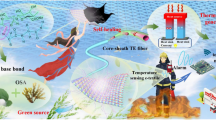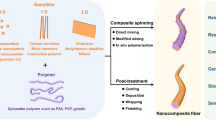Abstract
In this study, a novel sensor with high sensitivity and linear was prepared based on two-dimensional (2D) material (MXene) and ink, which can be used for deformation and damage monitoring of structural composites. The MXene was efficiently prepared by etching Ti3AlC2 powder with LiF–HCl solution and subsequent vacuum drying. The viscosity and adhesion of MXene/ink composites were controlled by changing the ratio of solvent (dimethyl sulfoxide) to ink. The MXene/ink was printed on the surface of the composite material to avoid forming defects in the composite material. The percolation threshold of the MXene/ink nanocomposite was relatively low, 3.6wt%. In this paper, MXene/ink composites with different contents were selected as the sensor, and the characteristics of the sensor were verified through monotone stretch and cyclic load-and-unload tests. When the MXene content just exceeds the percolation threshold (4wt%), the gauge factor (GF) of the sensor is higher, the results of monotonic tensile experiment show that there are two different sensitive stages of linear change (0 ~ 0.477%) and (0.477 ~ 1.37%), and the range GF is116.6 and 554.3, respectively. In addition, the linear relationship and sensitivity of the sensor remained stable after loading and unloading tensile tests. MXene/ink sensor has a broad application prospect in damage monitoring of aerospace structural composites.











Similar content being viewed by others
References
R. Moriche, A. Jiménez-Suárez, M. Sánchez, S.G. Prolongo, A. Ureña, Graphene nanoplatelets coated glass fibre fabrics as strain sensors. Compos SciTechnol 2, 6 (2017)
S.-J. Joo, M.-H. Yu, E.-B. Jeon, H.-S. Kim, In situ fabrication of copper electrodes on carbon-fiber-reinforced polymer (CFRP) for damage monitoring by printing and flash light sintering. Compos SciTechnol 142, 189–197 (2017)
K. Aly, A. Li, P.D. Bradford, Strain sensing in composites using aligned carbon nanotube sheets embedded in the interlaminar region. Compos A ApplSciManuf 90, 536–548 (2016)
Y. Song, A. Hehr, V. Shanov, N. Alvarez, N. Kienzle, J. Cummins, D. Koester, M. Schulz, Carbon nanotube sensor thread for distributed strain and damage monitoring on IM7/977-3 composites. Smart Mater Struct 23(23), 075008 (2014)
X. Wang, D.D.L. Chung, Continuous carbon fibre epoxy-matrix composite as a sensor of its own strain. Smart Mater Struct 5(6), 796 (1996)
A.F. Omar, Fiber Optic Sensors: An Introduction for Engineers and Scientists (John Wiley and SonsInc, London, 1997)
A.A. Barlian, W.T. Park, J.R. Mallon et al., Review: semiconductor piezoresistance for microsystems[J]. IEEE 97(3), 513–552 (2009)
G. Shu Daniel et al., Highly stretchy black gold e-skin nanopatches as highly sensitive wearable biomedical sensors[J]. Adv Elect Mater 44, 130–270 (2015)
B. Han, X. Yu, E. Kwon et al., Piezoresistive multi-walled carbon nanotubes filled cement-based composites[J]. Sensor Lett 8(2), 344–348 (2010)
T. Takeda, Y. Shindo, Z. Wei et al., Fatigue failure and electrical resistance behaviors of carbon nanotube-based polymer composites under uniaxial tension-tension loading in a cryogenic environment[J]. J Compos Mater 49(4), 457–463 (2015)
S. Lu, C. Tian, X. Wang et al., Strain sensing behaviors of GnPs/epoxy sensor and health monitoring for composite materials under monotonic tensile and cyclic deformation[J]. Compos SciTechnol 158, 94–100 (2018)
C. Bonavolontà, C. Camerlingo, G. Carotenuto et al., Characterization of piezoresistive properties of graphene-supported polymer coating for strain sensor applications[J]. Physical 252, 26–34 (2016)
S. Zhang, L. Wen, H. Wang et al., Vertical CNT-Ecoflexnanofins for highly linear broad-range-detection wearable strain sensor[J]. J Mater Chem C 6, 19 (2018)
Z. Jing, Z. Guang-Yu, S. Dong-Xia, Review of graphene-based strain sensors[J]. Chin Phys B 22(5), 057701 (2013)
A.F. Flannery, N.J. Mourlas, C.W. Storment et al., PECVD silicon carbide for micromachined transducers[C]. IEEE 3, 8 (1997)
M. Naguib, M. Kurtoglu, V. Presser et al., Two-dimensional nanocrystals produced by exfoliation of Ti3AlC2[J]. Adv Mater 23(37), 4248–4253 (2011)
M. Naguib, V.N. Mochalin, M.W. Barsoum et al., 25th anniversary article: MXenes: a new family of two-dimensional materials[J]. Adv Mater 26(7), 992–1005 (2014)
F. Bonaccorso, L. Colombo, G. Yu et al., Graphene, related two-dimensional crystals, and hybrid systems for energy conversion and storage[J]. Science 22, 13–67 (2015)
C. Zhang, H. Yin, M. Han et al., Correction to two-dimensional tin selenide nanostructures for flexible all-solid-state supercapacitors[J]. ACS Nano 8(6), 6509–6509 (2014)
Z. Hua, Ultrathin two-dimensional nanomaterials[J]. ACS Nano 9(10), 150925084953000 (2015)
G. Eda, S.A. Maier, Two-dimensional crystals: managing light for optoelectronics[J]. ACS Nano 7(7), 5660–5665 (2013)
M.W. Barsoum, MAX phases (properties of machinable ternary carbides and nitrides) mechanical properties: high temperatures[J]. Mech Prop (2013). https://doi.org/10.1002/9783527654581:363-397
J. Halim, K.M. Cook, M. Naguib et al., X-ray photoelectron spectroscopy of select multi-layered transition metal carbides (MXenes)[J]. Appl Surf Sci 1, 362 (2015)
A. Mishra, P. Srivastava, H. Mizuseki et al., Isolation of pristine MXene from Nb4AlC3 MAX phase: a first-principles study[J]. PhysChem 18, 8 (2016)
M. Naguib, V.N. Mochalin, M.W. Barsoum et al., Two-dimensional materials: 25th anniversary article: MXenes: a new family of two-dimensional materials [J]. Adv Mater 26(7), 982–982 (2014)
M. Naguib, J. Halim, J. Lu et al., New two-dimensional niobium and vanadium carbides as promising materials for li-ion batteries[J]. J Am ChemSoc 135(43), 15966–15969 (2013)
M. Ghidiu, M. Naguib, C. Shi et al., Synthesis and characterization of two-dimensional Nb4C3 (MXene)[J]. ChemCommun 50(2), 160–168 (2014)
K. Maleski, V.N. Mochalin, Y. Gogotsi, Dispersions of two-dimensional titanium carbide MXene in organic solvents[J]. Chem Mater 29(4), 1632–1640 (2017)
H. Wu, L.T. Drzal, Graphene nanoplatelet paper as a light-weight composite with excellent electrical and thermal conductivity and good gas barrier properties[J]. Carbon 50(3), 1135–1145 (2012)
B. Lundberg, B. Sundqvist, Resistivity of a composite conducting polymer as a function of temperature, pressure, and environment: applications as a pressure and gas concentration transducer[J]. J ApplPhys 60(3), 1074 (1986)
Y. Wang, J.W. Shan, G.J. Weng, Percolation threshold and electrical conductivity of graphene-based nanocomposites with filler agglomeration and interfacial tunneling. J ApplPhys 118(6), 065101 (2015)
B.E. Kilbride, J.N. Coleman, J. Fraysse, P. Fournet, M. Cadek, A. Drury et al., Experimental observation of scaling laws for alternating current and direct current conductivity in polymer-carbon nanotube composite thin films. J ApplPhys 92(7), 4024–4030 (2002)
W. Bauhofer, J.Z. Kovacs, A review and analysis of electrical percolation in carbon nanotube polymer composites. Compos SciTechnol 69(10), 1486–1498 (2009)
Q. Meng, J. Jin, R. Wang, H.C. Kuan, J. Ma, N. Kawashima et al., Processable 3-nm thick graphene platelets of high electrical conductivity and their epoxy composites. Nanotechnology 25(12), 125707 (2014)
N. Yousefi, M.M. Gudarzi, Q. Zheng, S.H. Aboutalebi, F. Sharif, J.-K. Kim, Self-alignment and high electrical conductivity of ultralarge graphene oxide–polyurethane nanocomposites. J Mater Chem 22(25), 12709 (2012)
D. Lee, H.P. Hong, C.J. Lee, C.W. Park, N.K. Min, Microfabrication and characterization of spray-coated single-wall carbon nanotube film strain gauges. Carbon Nanotube 22(45), 455301 (2011)
A. Ortega, B. Park, N.S. Kim, Printability and electrical conductivity of UV Curable MWCNT Ink[J]. J Electron Mater 44(3), 778–783 (2015)
X. Wang, J. Sparkman, J. Gou, Strain sensing of printed carbon nanotube sensors on polyurethane substrate with spray deposition modeling[J]. Compos Commun 3, 1–6 (2017)
A. Toldy, G. Szebényi, K. Molnár et al., The effect of multilevel carbon reinforcements on the fire performance, conductivity, and mechanical properties of epoxy composites[J]. Polymers 11, 2 (2019)
J.W. Zha, B. Zhang, R.K.Y. Li, Z.M. Dang, High-performance strain sensors based on functionalized graphene nanoplates for damage monitoring. Compos SciTechnol 123, 32–38 (2016)
L. Vertuccio, L. Guadagno, G. Spinelli, P. Lamberti, V. Tucci, S. Russo, Piezoresistive properties of resin reinforced with carbon nanotubes for health-monitoring of aircraft primary structures. Compos B Eng 107, 192–202 (2016)
S. Luo, W. Obitayo, T. Liu, SWCNT thin film enabled piezoresistivefiber sensors - fabrication, characterization and application for shm of polymeric composite structures[C]. StructDyn Mater Conf 4, 8–51 (2013)
Y.J. Kim, Y.C. Ju, H. Ham, H. Huh, D.S. So, I. Kang, Preparation of piezoresistive nano smart hybrid material based on graphene. CurrApplPhys 11(1), S350–S352 (2011)
Acknowledgements
The financial contributions are gratefully acknowledged. This work was financially supported by National Natural Science Foundation of China (U1733123, 11902204), Special Professor Project in Liaoning Province, Natural science foundation of Liaoning Province (20180550751), Education Department of Liaoning’s Item (JYT19041). The financial contributions are gratefully acknowledged. Innovative Talents Project of Higher Education Institutions in Liaoning Province (LR2019052), Shenyang Youth Science and technology innovation talent project (RC190004).
Author information
Authors and Affiliations
Corresponding author
Additional information
Publisher's Note
Springer Nature remains neutral with regard to jurisdictional claims in published maps and institutional affiliations.
Rights and permissions
About this article
Cite this article
Li, B., Ma, K., Lu, S. et al. Structural health monitoring for polymer composites with surface printed MXene/ink sensitive sensors. Appl. Phys. A 126, 791 (2020). https://doi.org/10.1007/s00339-020-03979-4
Received:
Accepted:
Published:
DOI: https://doi.org/10.1007/s00339-020-03979-4




